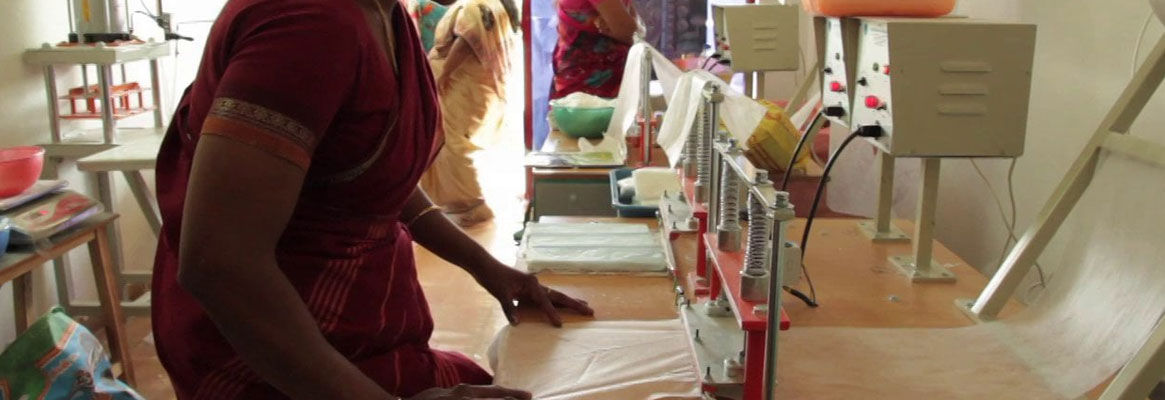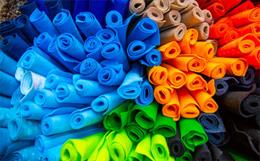The attainment ofpuberty in women is signified by menarche, the age of onset of menstruation.During menstruation, use of some kind of a protection in the form of a pad ornapkin is mandatory. The kind of sanitary protection practised duringmenstruation can determine the hygiene status of a woman, which can affect herreproductive health levels.
Many feminine hygiene products are available in the Indian market, their cost ranging between Rs.2.40 - 7.5 / napkin. With this cost profile, these products are being utilizedmostly by the upper middle and high-income group women. Also, the high product cost is a major deterrent in its utilization by the people of the low-income category.A need was thus felt to develop a low cost technology for the manufacture of products for sanitary protection, utilizing textile waste materials with similar properties.
A sanitary napkinbasically comprises of three layers; top layer, absorbent layer and barriersheet. The absorbent layer is the key component of the napkin and the extent towhich this layer is able to absorb and retain the fluid determines theefficiency of the napkin. This bulk layer of a napkin is a non woven web, madeof hydrophilic cellulosic staple fibers like wood pulp, cotton linters, viscoseetc (IS: 5405 1981). Most of the wood pulp used for the purpose is imported,and therefore expensive, increasing the overall cost of a sanitary napkin.Cotton is seen as a major fiber poised to replace wood pulp especially in thefeminine hygiene products where less bulky is preferred and thinner isbetter. The high cost of cotton is the reason why it has not been able toreplace pulp (Egelsbach, 2002). Hence, the possibility of using cotton of thelow cost knitwear waste is most appropriate to achieve value at less cost. Thewaste of the knitwear sector is typically from fully-fashioned garments or thetraditional cutnsew techniques. The cost of this cutting and sewing edgewaste varies from Rs.2 to 10 / Kg.
In the present study,an attempt has been made to develop low cost sanitary napkins by utilizingcotton fiber from knitwear waste. The process has been optimized and evaluationof the final product was done with respect to performance, comfort and hygieneparameters. The quality of the developed product was compared using specifiedparameters with four major brands of sanitary napkins in the Indian markets.
Methodology
Step I: Evaluationof the Branded Sanitary Napkins Available In the Markets
16 varieties of sanitary napkins of 4 major brands i.e.,Stayfree, Whisper, Kotex and Shapers were evaluated in terms of physical andmicrobiological parameters.
The cost profile of each brand and special features advertisedon their package cover were also compared. The Physical Parameters testedwere:
The fibre analysis of the selected sanitary napkin was donelayer wise, using the standard AATCC test methods. Preliminary identification wasdone using a light Microscope; the longitudinal view of the fibres was viewedunder the microscope. Chemical analysis of each layer was done to confirm thenature of fibers. Solubility tests were conducted to identify the cellulosicfibers and type of synthetic fibers. Melting Point process was used to identifythe type of Polyolefin fiber, viz. Polypropylene and Polyethylene.
Scanning Electron Micrographs (SEM) of the pulp fibers of regulartype napkins was prepared to ascertain the nature of cellulose fiber used.
2. Determination of pH
The pH of sanitary napkins was tested using the aqueousextracts of the samples by the cold method. The IS: 5405-1981 specification for sanitary napkins,specifies the test method for testing pH of a sanitary napkin.
3. Determination of Absorbency and ability to withstandPressure after Absorption
This test was conducted as per the IS: 5405-1981. The timetaken for the fluid to get completely absorbed by the napkin and the area ofthe spread of the fluid was noted. The sides and back of the napkin wereobserved for any fluid leaking through after placing a one Kg weight on it.
4. Flexibility of the Sanitary Napkins
Flexibility of the sanitary napkins was tested by the Modified Circular Bend Procedure. It is a test modeled after the standard ASTM circular bend procedure. The test apparatus used was an Instron inverted compression load cell, and the maximum force reading is the peak bending stiffness for that specimen.
5. Water Retention
The measurement of water retention was done by the standard ASTM Centrifuge method. Each prepared specimen was immersed in distilled water at room temperature for 5 minutes to completely wet it out. For ultra thin napkins the immersion time was for 2.5 minutes. The centrifuged specimen was weighed, dried and reweighed. Water retention was calculated and reported as a percentage of the dry mass.
6. Disposability
The disposability of the napkins was tested as per IS: 5405-1981. The napkin with the top and back covering removed was immersed in 15 liters of water and time taken to completely disperse in water was noted
The Microbiological testing of sanitary napkins was done to indicate the level of micro-organisms and common skin and uterine pathogens in the product.
1. Bacterial and Fungal Bio-burden
The testing was carried out by the Aerobic Plate Count method and the Yeast and Mould Count method for determining the bacterial and fungal Bioburden respectively using the standard method BAM, 2001. All Colony Forming Units (CFU) were counted including pinpoint size.
2. Presence of Staphylococcus aureus
Sanitary napkins were also tested for the presence of Staphylococcus
aureus using the standard test method IS: 5887 (part II) 2005. The saline
extracts of the samples were inoculated on Baird parker medium and the Baird
parker agar plates were incubated for 30 hours at 37˚C.
From the incubated plates the suspected colonies of the organism were looked
out for.
The quality of the branded sanitary napkins was ascertained on the basis of physical and microbiological properties.
Step II: Preparation of Cotton Knitwear Waste
1. Conversion to fiber form
The knitwear waste was in the form of uneven fabric pieces. It was converted into fiber form (suitable for making the absorbent core of a sanitary napkin), by the garneting process. The assessment of the mean length and uniformity of length of the fibers was done using the standard IS method. The average length of the fibers as well as the percentage of short fibers in it was noted.
2. Preparation of Web for Absorbent Layer of the Napkin
Washing of the fibers was done to improve their absorbency, softness and hygiene. Three different methods were used for washing; detergent, rewetting agent and alkali. The evaluation of suitability of a method was done on the basis of the enhancement of absorbency of the fibers and the pH with each method.
Step III: Development of Prototypes and Evaluation
Sanitary napkin prototypes were prepared in regular sizes using the optimized low cost fiber as the absorbent web. The designs were varied in terms of belt less and belted type varieties. Sterilization of the developed prototype was done in an autoclave as per the standard IS method.
Evaluation of the developed prototypes was done on the same test parameters as done for branded sanitary napkins. In addition, the developed prototypes were also tested microbiologically for presence of Candida albicans, a common pathogen of the uterus. The saline extracts of the samples was inoculated on Potato Dextrose agar and the agar plates were incubated for 48 hours at 25˚C. From the incubated plates the suspected colonies of the organism were looked out for. (Coneman, E.W., 1997)
Results and Discussion
Analysis of Garneted Knitwear Waste Fibers
Evaluation of the fiber length after garneting was done using a comb sotter. The results showed that the mean length was 16 mm, with 28% short fibers. Best washing results were achieved with detergent, recording a pH of 7.4 and absorbency (time of sinking in water) of 1.14 seconds.
Comparison of the Branded and Developed Prototype (Low Cost Sanitary Napkins)
Cost and Special Features
On an average, the cost profile of the branded napkins ranged from Rs. 2.40 to 7.50 / napkin. The Ultra-thin varieties were priced at almost 2-3 times more than the Regular types. The data shows that each brand offers a variety of sanitary napkins with regard to shape and thickness, such as with and without wings or with extra-large wings, Regular and Ultra-thin. Special features like stain-lock, odour-control systems, central absorbency zones etc. were advertised on certain packs and were promoted as the brands USP. The prototype prepared with cotton knitwear waste cost less than the cheapest variety available in the market.
Physical Parameters
Qualitative fiber analysis of the branded napkins revealed that the middle layer in all the napkins was mainly cellulosic fiber. The SEM showed fibers, some with convolutions and most fibers showed the presence of lignin and ray markings as seen in softwood fibers. The top and the barrier sheets were found to be polyethylene in nature for most brands. In some brands, the fiber nature of the cover sheet was found to be polypropylene.
All the branded napkins as well as the napkin developed from knitwear waste conformed to absorbency standards of BIS. 30 ml of test fluid flowed @15 ml/minute onto the samples was fully absorbed by all the napkins. The time taken for the fluid to get completely absorbed ranged from 5 seconds to 30 seconds among the various brands. Positioning of the napkin was found to be a critical factor in observing leak - through property. With a slight shift in position of the flow point, from the centre towards the sides, some napkins tended to leak through the sides and the fluid showed up at the back. Further, pH of all the samples was found to be within the range (6 to 8.5) suitable to the human skin. The napkin made from knitwear waste too conformed to the prescribed standard showing a pH of 7.7.
Water retention was measured by the centrifuge method to note the amount of water remaining in and on the napkin after a specified mechanical treatment. Water retention was found to vary from 174% to 630% for Regular branded napkins. The knitwear waste prototype exhibited 369% water retention. The water retention capacity of ultra thin napkins was found to much higher, ranging from 887% to 1341%. The water retention ratio of the centrifuged samples ranged from 5 times to 20 times the weight of the sample for branded Regular to Ultra thin napkins respectively. The knitwear waste prototype showed a water retaining ratio of 7 times the weight of the sample.
Flexibility was measured as force in grams, where, higher value indicated stiffer material. Branded Regular type napkins varied from 1369 to 3601 gm. and Ultra-thin ones ranged between 310 to 705 gm. The developed prototype was found to be much more flexible than most regular branded napkins; exhibiting a flexibility of 1869 gm. Flexibility was an indication of the softness of a napkin.
Disposability in water was seen in less than 5 minutes for almost all Regular type napkins, with fluff pulp as the middle layer. The middle layer of knitwear waste napkin also dispersed in water within 5 minutes. The brands which had an additional synthetic layer of material lining the absorbent core did not disintegrate at all. All the Ultra-thin napkins were found to be non-dispersible in water.
Microbiological parameters
Hygiene quality of the napkins was assessed on the basis of
their susceptibility to micro-organisms and common skin pathogens. Most napkins
were found to have a bacterial bioburden of less than 1000 cfu / ml
(internal standard of Johnson & Johnson Ltd.), even though the range within
brands was vast, between 10 to 955 cfu/ml. However, one brand exhibited a much
higher bacterial count of 1660 cfu/ml. Fungal bioburden for all the
napkins was within the acceptable range; 0 to 730 cfu/ml. The knitwear waste
prototype was assessed for bacterial and fungal counts before and after
sterilization. The counts of bacteria and fungi at both stages were found to be
low. No typical colonies of pathogen Staphylococcus aureus were
observed in any of the tested samples. The developed prototype was also tested
for presence of Candida albicans, a common pathogen of the uterus
known to cause urinary tract infections. No typical colonies of this pathogen
were observed.
Conclusion
From the results of the present study, it may be concluded
that low cost sanitary napkins of comparable quality as that of branded napkins
can be developed using cotton from knitwear waste as the absorbent layer. This will
enable the women from the lower economic strata to use the feminine hygiene
products to improve their reproductive health.
This will make disposable sanitary napkins affordable for the women of the lower economic strata and thus help to improve their status of menstrual hygiene management.
References:
- Bacterial Analytical Manual, Aerobic Plate Count, January, 2001,Chapter 3 &18
- Coneman, E.W., Allen, S.D., Janda, W.M., Color Atlas and Standard Book of Diagnostic Microbiology, E.D publications, Lipincott, 1997
- Egelsbach, AquaJet Spunlace System Technology for Cotton Fibers, Fleissner GmbH, Germany, May, 2002.
- Indian Standards, Specifications for Sanitary Napkins, (First revision), IS: 5405-1981, Indian Standards Institution, New Delhi.
- Osborn, T.W., Thin, Flexible Sanitary Napkin, US 4950264- Patent P & G, August, 1990, Cincinnati, Ohio.
About the author
Bhawana Chanana is a Reader with the Department of Fabric &
Apparel Science at Lady Irwin College, Delhi University. This research work is
a part of her Doctoral research work that she is currently pursuing in the area
of Design & development of Low cost Sanitary napkins. Work on the use
of other types of fibers from wastes of agro products is currently underway. A
need assessment survey has also been conducted amongst women belonging to lower
income category to assess the level of acceptance for low cost disposable
sanitary napkins.
To read more articles on Textile, Industry, Technical Textile, Dyes & Chemicals, Machinery, Fashion, Apparel, Technology, Retail, Leather, Footwear & Jewellery, Software and General please visit http://articles.fibre2fashion.com
To promote your company, product and services via promotional article, follow
this link: http://www.fibre2fashion.com/services/article-writing-service/content-promotion-services.asp








